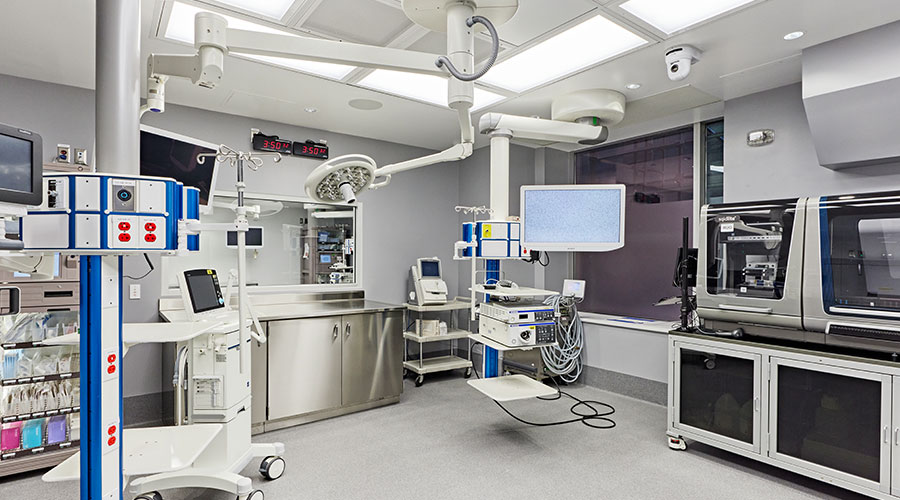“We had one chance to get it right,” says Christopher Rizzo, executive director of redevelopment, University Health Network, “Building two mini-operating rooms in a live suite of twenty sterile ORs. We’re talking about a city of individuals that are having different surgeries in sixteen to eighteen ORs at any one time.”
“The first day we did our site review was the day that COVID hit,” says Keith Button, senior architectural designer at Kearns Mancini Architects (KMAI), “We were on site when everything locked down. We had to get the Director of Infection Control at UHN to help us exit the hospital.”
Rizzo and Button are speaking about the design and building of the world’s first Organ Regeneration Laboratory (ORL) at Toronto General Hospital (TGH).
The TGH transplant surgeons who developed the regeneration technologies had been honing their techniques in an existing operating room. ORs can be up to 700 to 1,200 square feet so it was overkill for their spatial needs and not the best use of precious hospital resources. They brought the concept of a dedicated lab to Rizzo.
In the past, if organs were in any sort of trauma, if they weren’t perfect, they couldn’t be transplanted. The organ regeneration lab is using technology that was perfected at Toronto General; it’s called perfusion. Perfusion effectively keeps the organ alive for an extended period in a specialized environment like an incubator, which gives the team time to work on the organs and get them ready for transplant.
“Covid shut down elective surgeries,” says Button. “The ORL project freed up one of the ORs that they were using for a jerry-rigged version of the regeneration lab. Time was tight. We had to do the work as fast as we could so that the additional OR could be used to deal with the surgical backlog created by COVID.”
“These are the projects you do once in your life.” Rizzo says. “Two designated mini-ORs that have created the ability to regenerate or repair organs for transplant. There’s a third area which is called the islet room that harvests stem cells from a pancreas, and is being used to treat diabetes, reversing the effect of the disease in some patients.”
Toronto General completes 1200-1400 transplants a year, with a success rate hovering around 98 percent.
“We’re in pretty esteemed company on a global scale,” says Rizzo. “We were the first to transplant a lung and the first to transplant double lungs. Right now, if a recipient needs double lungs, they are getting them in one operation. Our track record is probably the best you can get for surviving major transplants.”
Ground-breaking work is being done in these facilities, but breaking ground to build them was just as challenging.
“It was like playing Tetris in a fully functioning operating ward,” says Button. “We couldn’t do one thing without it affecting something else. We had to free up three rooms that were already in use. One for perfusionists, another for anaesthetists and an equipment storage room. Just to free up these three rooms we had to renovate 12 locations in the hospital - most of them in the operating suite itself.”
Due to the tight schedule and a need for experienced team players, the design-build team of Dineen Construction and Kearns Mancini Architects was selected to deliver the project.
“From start to finish,” comments Rizzo. “We did the project in less than 12 months, so it was a monumental task.”
The greatest concern for the surgeons was headroom. A lot of equipment on articulated arms is hung from the ceiling in a typical OR. There needed to be enough clearance so that the equipment did not clash, however ORs normally have a 10-to-12-foot ceiling height. The rooms being renovated for the regeneration lab did not have more than eight feet of headroom. The design/build team from Dineen/KMAI had to work with manufacturers of the lighting and equipment booms to have the least possible depth of the equipment overhead.
The Organ Regeneration Lab is a lab and a studio at the same time. What you see in the OR is a large light fixture with high intensity lighting for the work over the organ. Everything in the room is done under high-definition video recording, so it can be viewed in any part of the world as it is happening. A 4K high-resolution camera built-in within the light fixture is centred perfectly over the surgeon’s table. There are microphones and speakers all over the ceiling. While the surgeons are working in the lab, they are also teaching other professionals around the world how to perform the work.
For Rizzo, “One of the biggest aspects was to put in a dedicated medical grade air handling unit to provide the air changes that were required for an ultra-sterile environment.”
“The islet room is considered on par with a pharmaceutical lab,” adds Button. “It requires 40 air changes an hour. The bio-hood in that room worked in reverse. They are dealing with cell cultures. Normally a hood would be protecting you, but here the hood was protecting what was in the hood from you. The room must be HEPA filtered and positively pressurized. So, the mechanical systems were enormous. A completely independent system.”
These two labs had to remove pathogens. Most organs are worked on within a glass box, so they are not exposed to the room proper. They are within their own environment, but the rooms must be ultra-sterile.
“This is cutting edge.” says Rizzo. “The intricate layout means you must be quite disciplined. The ergonomics had to be tested and proven in detail. Where is the med gas? Are the services within reaching distance of the surgeons in a very tight space? When the surgeon is working around the medical bench - where they work shoulder to shoulder – there must enough freedom for the surgeons to do their job, but the equipment must be right at their side so it’s within reach. The sightlines, the lighting, the microphones. It’s all recorded. So, viewers can see it in real time.”
Button spent weeks meeting with their partners, Dineen Construction. The tight tolerances. Putting everything within reach. Plotting out the ergonomics. Trying to gain five millimeters in ceiling height to hang equipment. There was so little space above the ceiling in the islet room that they couldn’t suspend the ceiling. It had to be supported from underneath.
How do you build within a sterile environment during a Covid lockdown?
“The trades had to go through the OR suites to access the regeneration rooms.” says Button. “They gowned up like they were surgeons. When they made it through COVID protocols they ditched their street clothes and switched into scrubs. Eventually, the contractors gave them scrubs to put over street clothes. Masks and hairnets. They would come in to do their work, then dispose of their PPE. There was no coming and going. None. The trades on site had to stay there for the entire day.”
“Kearns Mancini asked all the right questions,” says Rizzo. “They understood the sensitivities. They understood that they couldn’t breech a sterile environment, so following the rule to gown up in the area, removing gowns just like the medical staff and being precise in the way they executed the project was no different than the precision of the surgeons. A very successful project. Our number one win of the year.”

 Oracle Health Hit by Data Breach, Patient Data Possibly Compromised
Oracle Health Hit by Data Breach, Patient Data Possibly Compromised Ground Broken on New MD Anderson Sugar Land Facility
Ground Broken on New MD Anderson Sugar Land Facility Florida State University Reveals Plans for Panama City Beach Hospital
Florida State University Reveals Plans for Panama City Beach Hospital The Effect of Over-Cleaning on Human Health
The Effect of Over-Cleaning on Human Health